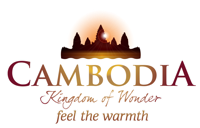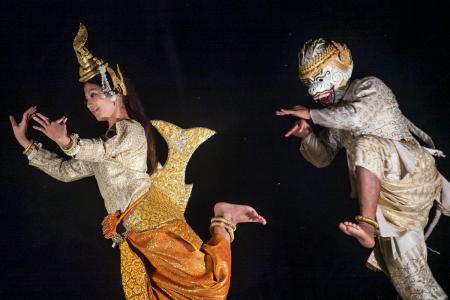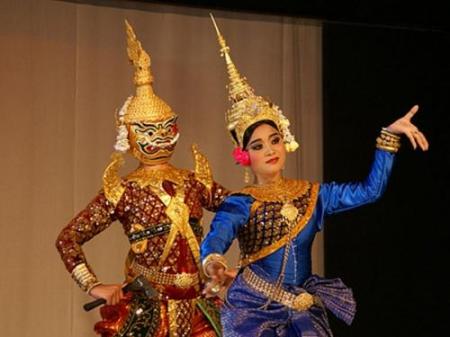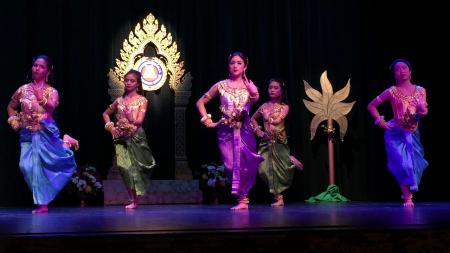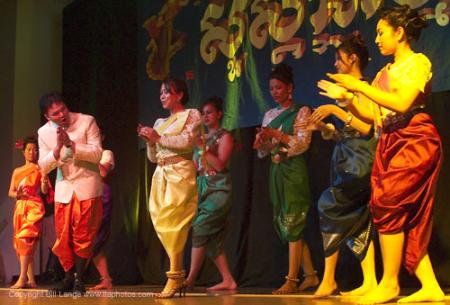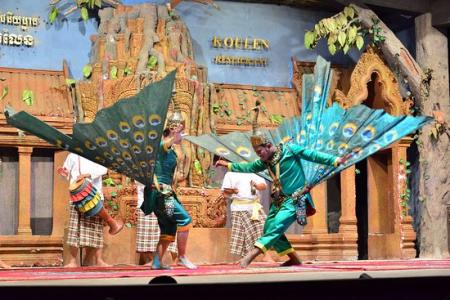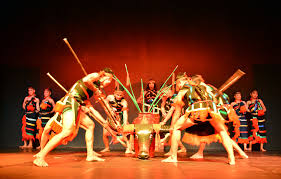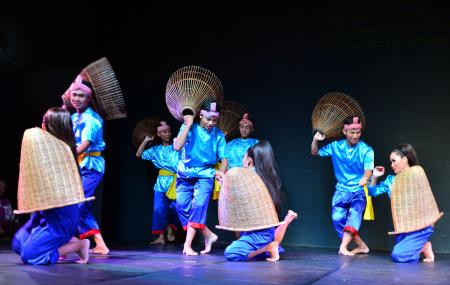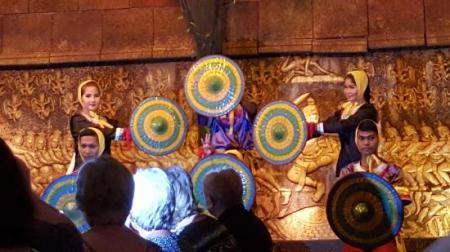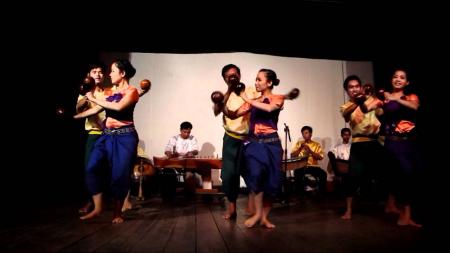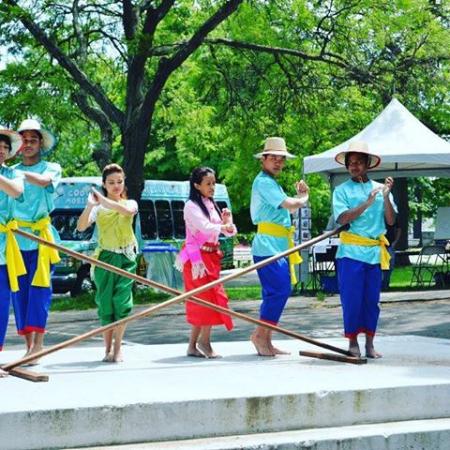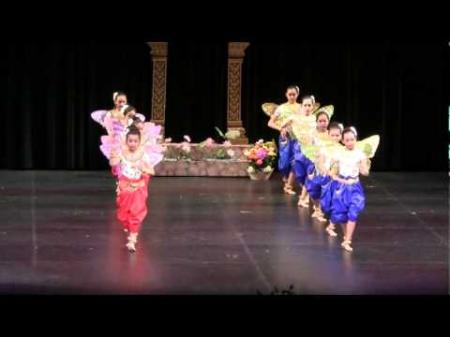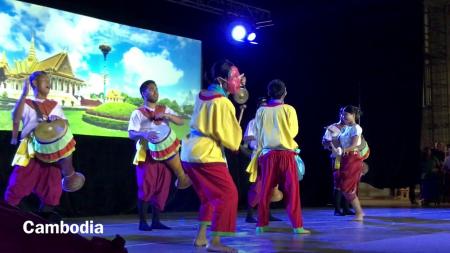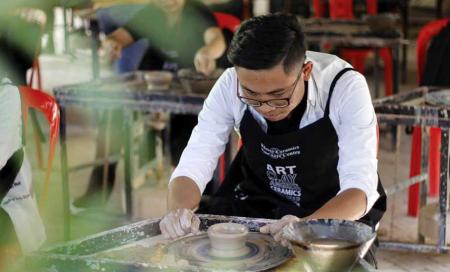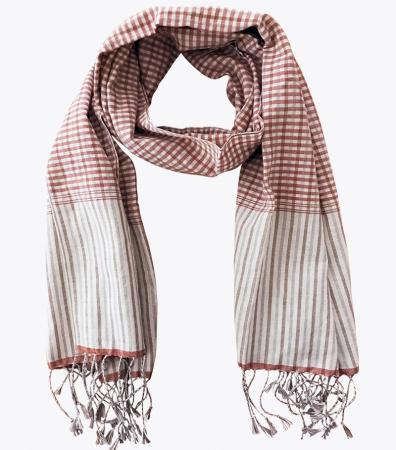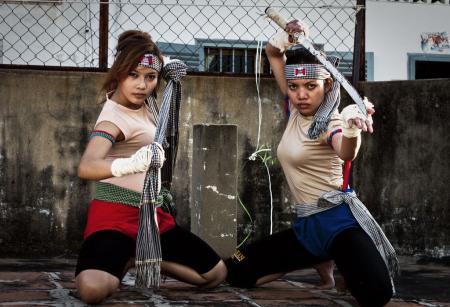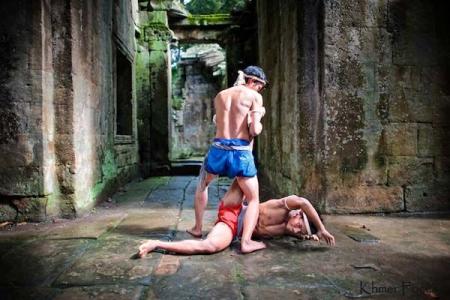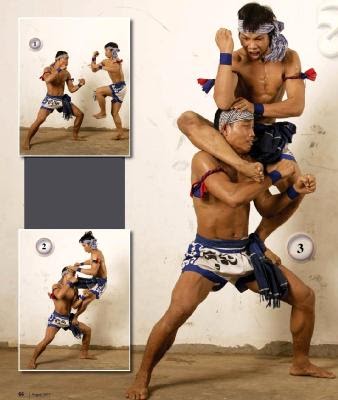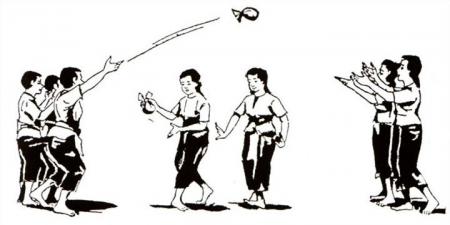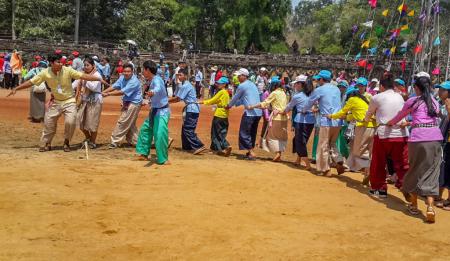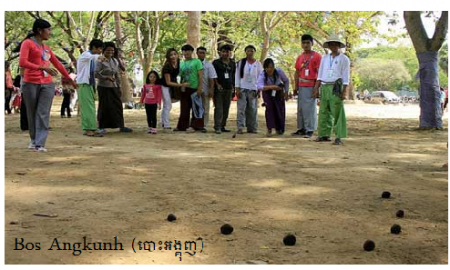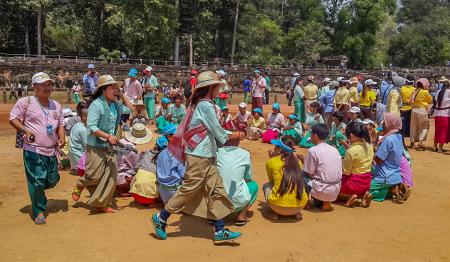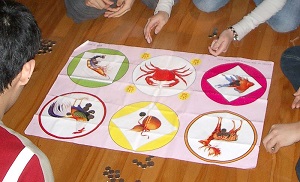The history of Cambodian culture and art stretches back centuries to ancient pottery, silk/ basket weaving, and stone carving. The height of Khmer art occurred during the Angkor period; much of the era’s stone carving and architecture survive to the present. In ancient times, art and crafts were generally produced either by rural non-specialists for practical use or by skilled artists producing works for the Royal Palace. In modern times, Cambodian culture and art have been carefully considered as the tourist market has increased and governments and NGOs have contributed to the preservation of Cambodian culture.
The Cambodian produce many hand-made items including rattan furniture, intricate stone and wood carvings, colorful woven mats and baskets, and a variety of silver and silk ware. Many of these items are used regularly in the daily lives of the Cambodian people.
You can readily witness master artisans at work and purchase such gifts in markets and specialty shops throughout the Phnom Penh Capital, Siem Reap Province, Preah Sihanouk Province, and other potential provinces of Cambodia.
- Cambodian Dancing
The Cambodian dancing comes into three categories, namely classical dance that is performed in the royal courts and at cultural festivals, folk dance that portrays everyday life, and vernacular dance which is performed for social functions.
1.1. Khmer Classical Dance or Cambodian Royal Ballet
(Declared “Intangible Cultural Heritage of Humanity” by UNESCO on 7 November 2003)
The Khmer Classical Dance, also known as the Cambodian Royal Ballet, was originally performed only for royalty, but now is also held for dignitaries and the public at major official festivals and at theaters. It is called “Rabam Preah Reachea Troap” in the Khmer language, which means the dance of royal property.
The classical dance, playing a significant role in Khmer literature, encompasses Apsara, Tep Monorom, Sovann Machha, Moni Mekhala, Makara, Neary Cheachuor, Phuong Neary, etc.
- Apsara Dance
Involving a fragment of the Ramayana “the ancient Indian epic”, the Apsara Dance has had its roots in Hindu animism since the 1st century.
During the Angkor era (the reigns of King Jayavarman II to VII), this dance took on its own unique form, graceful movements, and deep meaning. By the 13th century, it was the typical Khmer than the Indian. The images of wanton dancers, adorned with gold headdresses and silken tunics and skirts, were carved on the walls of Angkor Temple and many other temples. Three thousands of Apsara images were found on the walls of the 12th-century court of King Jayavarman VII.
Over the centuries, classical Khmer dancing lent its influence to the classical ballet of the neighboring countries. Some of its postures and movements are similar to other Southeast Asian dancing. However, Princess Bopha Devi said, “The Khmer kingdom started its cultural tradition in the 8th century, 500 years before Thailand.”
Based on Khmer mythology on bas-relief on the walls of the Angkor Temple, all of Apsara dancers “heavenly women” were born from the foam surface of the ocean of milk when Devoda (heavenly beings) and Assura (demons) churned the ocean of milk with the gigantic Naga in search for the elixir of immortality.
This dance portrays Mera dressed in white for purity, dancing in her garden. She is accompanied by her handmaidens “Apsara”. They all produce flowers expressing great love of the people and the country.
The Apsara Dance is deemed to be a main part of the Royal Ballet of Cambodia, which was declared “Intangible Cultural Heritage of Humanity” by UNESCO on 7 November 2003, and it is particularly valued as a national art treasure.
- Tep Monorom Dance or Happiness Dance of the Gods
The Tep Monorom Dance typifies all the grace, elegance, beauty and refinement that define the Cambodian classical dance repertoire. It reflects the highly formalized and ritualistic relationships between male and female gods. The dancers portray the Cambodian gods and goddesses of antiquity descending from the heaven and enveloping the earthly realm in happiness and joy.
The mannerisms of the gods are adopted as part of the Cambodian court ritual and as an artistic courtship ritual.
- Sovann Machha Dance or Golden Mermaid Dance
Sovann Machha Dance is a short scene of the classical ballet, actually excerpted from a famous Cambodian legend called Reamkér (Ramayana), on the episode of King Ream mobilizing monkey forces to build a stone bridge to liberate Neang Sita who had been captured by Rahwana, the giant king of Lanka.
In this dance, Hanuman, the white monkey general, led an army of monkeys to build a bridge across the ocean to rescue the captive princess. As they piled up stones for the bridge, the stones mysteriously disappeared. Hanuman dived into the sea to investigate and discovered a beautiful golden mermaid, named Sovann Machha, who had ordered shoals of fish as her entourage to bring out the stones obstructing their traffic. When he saw her, he fell in love with her and soothed her. With his clairvoyance, Hanuman persuaded her to order shoals of fish to transport stones to rebuild the bridge, leaving an appropriate passage in the center to let her and her entourage go through. After they rebuilt the bridge successfully, he disguised himself as big to fill that passage and ordered his army to cross this bridge to fight against the enemies. He eventually defeated Rahwana and liberated the princess.
- Moni Mekhala Dance or Moni Mekhala Drama
Moni Mekhala Dance, or Moni Mekhala Drama, is the story involving two of the Cambodian deities, Moni Mekhala (Goddess of Water) and Ream Eysor (Storm Spirit). These two have been engaged in a celestial contest of wills as the Storm Spirit tries to steal a magic crystal ball from the Water Goddess, the source of her enormous power. At first, the Storm Spirit tries to beguile Moni Mekhala with flattery and charm. The Water Goddess will not have any of it. Wise to the ways of the Storm Spirit, she rejects his advances and makes a mockery of his efforts. This enrages the Storm Spirit and the battle is joined. As he advances toward the goddess, Eysor brandishes his magic axe. With precision and grace, the goddess counters him by displaying her crystal ball, by blinding the Storm Spirit, and by staggering him. Frustrated by one repulse after another, the Storm Spirit is forced to concede defeat and withdraw, muttering that he will seek his revenge another time.
According to the popular Cambodian legend, the thunderstorm is all that we mortals are allowed to see of this recurrent battle in the heaven, with lightning representing Moni Mekhala’s crystal ball and thunder representing the Storm Spirit’s magic axe clattering across the heaven as it slips from his nervous fingers.
This dance is said to symbolize the victory of virtue over seduction. The Moni Mekhala drama represents Cambodian storytelling at its best.
- Makara Dance or Mkor Dance
Makara Dance, or Mkor Dance, is one of the great sacred dances of the court repertoire relevant to the domain of gods, symbolizing water, earth, fire, and wind. It is performed to remind us of the victory of the Khmer Navy during the Angkor period.
Annually, this dance is performed for His Majesty Preah Bat Samdech Preah Baromneath Norodom Sihamoni, the King of the Kingdom of Cambodia, and Samdech Preah Maha Ksatrei Norodom Monineath Sihanouk, Cambodian Queen-Mother with Freedom, Dignity and Happiness, at the royal banquet in the Chann Chhaya Pavilion during the final day of the Water Festival.
As regards the above-mentioned dance, Mkor is an aquatic creature symbolizing bliss. Mkor in full regalia opens its mouth and bites a crystal ball to please the eyes of all on-lookers.
- Neary Cheachuor Dance
Neary Cheachuor Dance is a Khmer classical dance describing the beauty of young women in their elegant costumes. This dance reminds the Khmer people of the rich culture that has been kept and nourished through generations, and it is well known among the neighboring countries.
- Phuong Neary Dance
The Phuong Neary Dance accompanied by the music and the melodic song admirably describes the great beauty of a Khmer woman compared to a golden flower. Although she is practical and strong, she is admirable and soft.
- Fan Dance
The Fan Dance is performed to represent Indra’s blessing and to express best wishes to Khmer sovereigns and their people.
- Seven-Day Color Fashion Show
It shows seven beautiful Cambodian women dressed in vibrant color Phamuong for seven days of the week: Sunday – Red, Monday – Yellow-Orange, Tuesday – Purple, Wednesday – Mustard-Green, Thursday – Green, Friday – Blue, and Saturday – Burgundy. On special occasions, the Cambodian people believe that choosing the right color of clothes in accordance with the color chart will bring good luck and happiness.
1.2. Folk Dance
The folk dance here refers to a performing art, which is performed for an audience. This dance is fast-paced. The movements and gestures are not as stylized as the Khmer classical dance.
The folk dance comes into two forms: ceremonial and theatrical. Generally, the theatrical folk dance is presented in public performances, and the ceremonial folk dance is reserved for particular rituals, celebrations and holidays. The theatrical folk dance, such as the popular Harvest Dance and the romantic Fishing Dance, is usually inspired by rural life and practices of hill tribes, farmers, and peasants. Some folk dances are about love, or are folktales about animals.
The folk dance music is played by a Mahori orchestra, which is similar to a Pinpeat orchestra except that it contains many stringed and plucked instruments and a type of flute in place of the Sralai (an oboe-like instrument).
- Peacock Dance
The Peacock Dance shows a courting scene between a peacock and a peahen, representing happiness and prosperity of the Pailin province of Cambodia. During the Khmer New Year and other festivals, this dance is performed to show the Kola people’s tradition and their exploitation of precious gems in Pailin Province.
- Buffalo Sacrifice Dance
The Buffalo Sacrifice Dance is inspired by rural life and practices of Phnorng hill tribes living in Rattanak Kiri and Mondul Kiri provinces located in the northeastern part of Cambodia. A buffalo sacrifice is to express their gratitude to tutelary spirits for blessing their crops. They drink rice wine and dance around the jar as a libation for perfect harmony and supernatural power.
- Fishing Dance
The Fishing Dance is a dance symbolizing love and romance of the young people in a fishing quarter. Love and romance are favorite themes in Khmer stories and dance. In the traditional Cambodian society, young people are carefully watched and do not have many opportunities to get to know one another. However, the fishing quarter is one place where they have the chance to meet.
- Cardamom-Picking Dance
The Cardamom-Picking Dance is performed to show livelihood of the Poar people inhabiting the highland in Pursat Province, Cambodia. Their farming includes growing teas, picking cardamoms, harvesting fruits, and extracting sap.
- Coconut Shell Dance
The Coconut Shell Dance is <a Khmer traditional dancing with dancers knocking coconut shells together to sound sweet. It is truly held to mark the harvest season in Cambodia and to show a close romantic relationship between young men and women during the harvest.
- Pestle Dance
The Pestle Dance has originated from the ethnic minority, Kuoy, who have derived the dance style from their daily life activities. It is usually performed during the Khmer New Year and during the post-riceharvest time.
- Phloy
Phloy is a gourd-shaped wind instrument the ethnic groups always use and preserve. Originating in Kampong Speu Province of Cambodia, the Phloy Dance is a kind of folk dance with dancers blowing Phloys. This dance is performed to commemorate the origin of time and the myth of the eternal return. It is associated with legends from India to Southeast Asia.
- Butterfly Dance
The Butterfly Dance illustrates a story of bug busters working diligently to maintain the garden and keeping unwanted bugs away. At the same time, a group of young female butterflies is flying, singing, and looking for pollen to extract in the garden. To their surprise, the butterflies are quietly caught by the bug busters. They try to convince the bug busters to release them by claiming they were just beautifying the garden.
- Mantis Dance
The Mantis Dance has originated in Svay Rieng Province, Cambodia. This dance imitates a mantis’s gesture. During the dance, the dancers beat coconut shells to produce an attractive sound. Each dancer uses three pairs of coconut shells, one pair in hands, one pair on the elbows and another pair on the knees. It is performed during Khmer ceremonies to show happiness and prosperity nationwide.
- Kantèrè Dance
The Kantèrè Dance is a traditional Khmer dance representing ancient Khmer civilization. Once upon a time, there was a daughter of Neak Sachaing named “Kantèrè”. One day, she was bored and decided to pass time under a tree with her two tiger-followers. While Kantèrè was dancing, two tigers tapped their feet in rhythms. She was dancing while caressing the tigers to the left and to the right. That time, a hunter observed the scene and reported to the king. The king ordered the followers to invite her to perform for him. Since then, it has become a traditional Khmer dance.
- Kèn Dance
The Kèn Dance has originated in the northeast province of Cambodia. It is traditionally performed when the Cambodian gather to celebrate the Khmer New Year. Like many Cambodian folk dances, the Kèn dance has a courtship theme. Many of the young men in this part of the country play a mouth organ called “Kèn” made of strips of bamboo and decorated with flowers. The dance demonstrates how men would play music in the open area of villages to attract young women passing by.
- Drum Dance or “Chhay Yam Dance”
The Drum Dance is a kind of folk dance the Cambodian people believe that whenever drums are beaten together, they always take away the evils from the village. The dance with a comic is performed during traditional Khmer festivals to bring happiness, prosperity, and victory back to their whole family. It makes the audience laugh, enjoy, and forget all of their sadness.
- Palm-Leaf Hat Dance
The Palm-Leaf Hat Dance, a sense of Khmer national identity, is impressively performed to promote artistic creativity in the Khmer ancestral palm-leaf hats and to attract support for the protection and conservation of Khmer sugar palms.
1.3. Vernacular Dance or Social Dance
The vernacular dance, or social dance, is performed at social gatherings, including Ram Vong, Ram Kbach, Saravan, Lam Leav (literally, “Lao dance”) and so on. Some of these dances have much influence from the traditional dances of Laos. Nevertheless, Ram Kbach, for example, takes heavily from the classical dance of the royal court. Ram Kbach is a simple dance performed with hand gestures similar to the classical dance and with classical songs combined with traditional Khmer and Western instruments.
Other social dances from around the world, including Chha-chha, Bolero, and Madison, have had an impact on the Cambodian social culture. Such dances are often performed at Cambodian wedding receptions and banquets.
- Khmer Shadow Theater
The Khmer Shadow Theater comes into two forms: Sbèk Thom (big puppets that are actually panels depicting certain characters from the story) and Sbèk Toch (small articulated puppets). The black leather puppets are held in front of a light source, either in front of or behind a screen, creating a shadow or silhouette effect. Sbèk Thom is the more unique feature, restricting itself to stories from the Reamker. The performance is accompanied by a Pinpeat orchestra and by narration, and the puppeteers move the panels like a dance. Sbèk Toch, having a far lighter feel, presents popular stories of heroes, adventures, love and battles, with or without orchestra and with the puppeteers often doing the narration.
The Khmer Shadow Theater “Sbèk Thom” was declared “Intangible Cultural Heritage of Humanity” by UNESCO on 25 November 2005, and it is particularly valued as a national art treasure.
- Handicrafts
The Cambodian produce many hand-made items including rattan furniture, colorful woven mats and baskets, pottery, ceramics, and a variety of silver and silk ware. Many of these items are used regularly in the daily lives of the Cambodian people.
- Work of Silversmiths:
The work of silversmiths reached its height during the 11th century when artisans attained perfection. Workshops supported by the Royal Palace and the School of Fine Arts also flourished from the 19th century to the early 20th century.
Today, riparian artisans predominate in Kampong Luong District, Kandal Province. They use silver imported from Laos and China. It varies in purity from 70-92 percent. Artisans produce objects such as Buddha images, jars, chopsticks, jewelry, knives, forks, and tiny ankle chains “Chang Krang Cheung” for babies. Small betel nut boxes in animal motifs such as rabbits, ducks, cats, deer and citrus fruits are most popular. Ornate filigree work is in the Khmer traditional style. Contemporary silverware can be found at various markets and shops in Phnom Penh and Siem Reap.
- Silk Weaving:
Silk weaving can be seen in Koh Sotin District, Kampong Cham Province; Kean Svay District, Kandal Province; Bati and Prey Kabas Districts, Takeo Province; Prèk Changkran District, Prey Vèng Province; and Prèk Luong and Koh Dach Districts, Kandal Province.
The traditional silk weaving of Cambodia is purely decorative. Weavers form sophisticated patterns of birds and flowers, mythical and realistic, often depicting Khmer tales, scenes from Angkor Temple, and the life of Lord Buddha. They today produce a style of intricately patterned and dyed silk called “Kha Bang Neang Sok Kra Ob”.
Designs incorporate images of flowers, animals, peacocks, crowns, jewels and other motifs inspired by the Angkor era, or handed down from previous generations. Dyes are made from plants in glowing hues of greens, blues, violets, ochres and reds.
The technique involves wrapping strands of raw silk on to a frame, and then tying the strands with banana-leaf threads into patterns. The silk is removed, dyed, and remounted on the frame to be re-tied for the other colors in the pattern, up to five times. Base color silk is strung lengthwise on to the loom. The dyed threads are the wefts, the crosswise threads, woven into the pattern originally created by the tie-dying process.
It takes a week to string the warp threads onto the loom, and two weeks to weave a length of silk for a Sarong. Various silk products include checkered Sarong and Sampot worn at home and patterned Hol and Phamuong worn on formal occasions.
- Scarf Weaving:
Cotton and silk scarf weaving is very popular with Cambodian residents inhabiting Kandal, Takeo, and Kampong Cham provinces. Since ancient times, Cambodian farmers have used a scarf as a bathing cloth, a piece of fabric worn for warmth, or a decoration around the neck or over the shoulders or hair. Furthermore, this scarf is generally used to wrap their food in when they go to field.
- Non-textile Weaving:
Many Cambodian farmers weave baskets (Tbanh Kantrak) for household use or as a supplemental source of income. Most baskets are made of thinly cut bamboo. Regions known for basketry include Siem Reap and Kampong Cham. Mat weaving (Tbanh Kantél) is a common seasonal occupation. Mats are most commonly made from reeds, either left a natural tan color or dyed in deep jewel tones. The region of Cambodia best known for mat weaving is the Mekong floodplain, especially around Lvea Em district. Mats are commonly laid out for guests and are important building materials for homes. Wicker and rattan crafts (Tbanh Kanhcheu) are also significant. Common wicker and rattan products include walls, mats, furniture, and other household items.
- Ceramics:
Cambodian pottery traditions date to 5000 BCE. Ceramics in the shape of birds, elephants, rabbits, and other animals were mostly used for domestic purposes such as holding food and water. It was very popular with the Cambodian people, especially members of the royal families between the 11th and 13th centuries.
Potting traditionally was done on a pottery wheel or using shaping tools such as paddles and anvils. Firing was done in clay kilns, which could reach temperatures of 1,000-1,200 °C, or in the open air, at temperatures of around 700 °C. Primarily green and brown glazes were used. In rural Cambodia, traditional pottery methods remain. Many pieces are hand-turned and fired on an open fire without glaze. The country’s major center for pottery is Kampong Chhnang Province.
- Wat Murals
Few historic Wat murals remain in Cambodia. The best-known surviving murals are at the Silver Pagoda in Phnom Penh, Wat Rajabo in Siem Reap province, and Wat Kampong Tralach Leu in Kampong Chhnang Province. Cambodia’s surviving older murals are generally more refined and detailed.
- Lacquer Ware
Cambodian traditional lacquer ware reached its height between the 12th and 16th centuries. Some examples of work from this era, including gilded Buddha images and betel boxes, have survived to the present day. Lacquer ware was traditionally colored black using burnt wood, representing the underworld, red using mercury, representing the earth, and yellow using arsenic, representing the heaven. Lacquer on Angkorian stones dates to the 15th or 16th century.
In modern Cambodia, the art of lacquer work nearly faded into oblivion: few lacquer trees survived, and lacquer was unavailable in local markets. Today’s revival is still in its infancy, but 100 lacquer artists have been trained by a French expert under the guidance of Artisans d'Angkor, a company that produces traditional crafts in village workshops. Some artists are beginning to experiment with different techniques and styles to produce modern and striking effects.
- Stone Carving
Cambodia’s best-known stone carving adorns the Angkor temple renowned for the scale, richness and detail of its sculpture. During the late 20th century, efforts to restore Angkor resulted in a new demand for skilled stone carvers to replace missing or damaged pieces, and a new tradition of stone carving is arising to meet this need. Most modern carving is traditional-style, but some carvers are experimenting with contemporary designs. Interest is also renewing for using stone carving in modern pagodas. Modern carvings are typically made from Banteay Meanchey sandstone.
- Martial Arts
Khmer martial arts date back more than a thousand years, as evidenced by carvings and bas-reliefs in the Angkor temple. The martial arts include Bokator, Pradal Serey, Baok Chambab, Kbach Kun Dambong Vèng, etc. Nowadays, they are particularly popular with youths and visitors.
- Bokator “an Ancient Khmer Boxing Art”
Bokator, known formally as Lbokkator (which means wielding a wooden stick to fight lions), is an ancient Khmer martial art said to be the predecessor of Southeast Asian kickboxing styles. Depicted on the bas-relief on the walls of Angkor Temple, Bokator was the close quarter combat system used by the armies during the Angkor era. It is believed that King Jayavarman VII, the illustrious ruler of the Khmer Empire, was a practitioner of Bokator. Bokator weaves together ancient Cambodian religious traditions of Buddhism and Brahmanism.
Unlike kickboxing that is a sport fighting art, Bokator was a soldier’s art used on the battlefield. It can be considered a complete martial art, using strikes, throws, drags, trapping, locking, and some elements of ground fighting. Every single part of the body can be used as a weapon. Bokator practitioners are trained to strike with knees, hands, elbows, feet, shins, and head. Even the shoulders, hip, jaw, and fingers can be used to fight an opponent to submission or death.
When fighting, Bokator practitioners still wear the uniforms of ancient Khmer armies. A Kroma (scarf) is folded around their waist and blue and red silk cords called Sangvar are tied around the combatants’ head and biceps. In the past, it is said that the cords were enchanted to increase strength, although now they are just ceremonial.
The Kroma shows the fighter’s level of expertise. A series of grades, each taking at least five months to complete training seven days a week and two hours a day, are represented by different colors. The first grade is white, followed by green, blue, red, brown and then black which has ten degrees.
After completing their initial training, fighters wear a Black Kroma (scarf) for at least ten years. To attain the Gold Kroma you must be a true master and must have done something great for Bokator. Moreover, to become a true master, it will definitely take some time as just in the unarmed portion of the art there are between 8000 and 10000 different techniques, only 1000 of which you have to learn to attain the black Kroma.
The art contains 341 different styles some of which are the duck, crab, horse, bird, dragon, eagle, crane, wind, fire, water, earth (or stone), king monkey, lion, elephant, Apsara (traditional Hindu sacred nymph), and crocodile.
Because of its visually similar style, Bokator is commonly wrongly described as a variant of modern kickboxing. Bokator has many forms based on styles as well as practical fighting techniques.
- Pradal Serey “Khmer Kickboxing”
Pradal Serey is a traditional Khmer kickboxing. A match consists of five rounds and takes place in a boxing ring. There is a one- or two-minute break between each round. Before a match, boxers perform the praying rituals known as Kun Krou. Traditional Cambodian music is played during the match. The instruments used are Skor Yaul (a type of drum), Sralai (a flute-like instrument), and stringed Chhing. Boxers are required to wear leather gloves and shorts.
Rules:
- A boxer is not allowed to strike his opponent while he is on the ground.
- A boxer is not allowed to bite.
- When an opponent cannot fight anymore, the referee stops the fight.
- Blows to the back of the opponent are not allowed.
- A boxer may not hold on to the ropes.
- Blows to the genitals are prohibited.
Victory is instantaneously granted when a boxer knocks another boxer out and the boxer knocked down is unable to continue fighting after a 10-second count by the referee. Victory is also determined at the end of the match when judges decide by a point system which a fighter was more effective. If fighters end up with the same score, a draw is called.
Pradal Serey has made a strong comeback since its banishment back in the 70's. Numerous gyms have opened and large masses of students, local and foreign, have come to train in Cambodia. There are currently about 70 boxing clubs.
Matches are held weekly at CTN Station, Bayon Television Station, Phnom Penh Municipal Television Station, and Kong Yothapol Khemara Phoumin Television Station, and these are televised live.
- Baok Chambab “Khmer Wrestling”
Baok Chambab is Khmer wrestling in which two opponents try to pin (hold) each other's back to the ground. A match consists of three rounds. Wrestlers perform pre-match ritual dancing. A wrestler wins a match by two of three rounds. However, after each round, the loser is asked if he wishes to continue with the match. The match is accompanied by the music of two drums known as Skor Nhy and Skor Chhmol “female drum and male drum”.
Traditional matches are held at the Cambodian National Olympic Stadium during the Khmer New Year and other Cambodian holidays.
- Kbach Kun Dambong Vèng “Long Staff Art”
Kbach Kun Dambong Vèng literally refers to an ancient Cambodian martial art form involving the use of a long staff. It has traditionally been practiced to prepare to fight against enemies bearing eventual malice towards their villages and their country. Nowadays, it is particularly popular with youths in main sport clubs in Cambodia.
- Kite-flying
Cambodia’s kite-making and kite-flying tradition, which dates back many centuries, was revived in the early 1990s. It is now extremely popular throughout the country. Kites (Khlèng Ek) are generally flown at night during the northeast monsoon season. A bow attached to the kite resonates in the wind like a musical sound.
- Traditional Games
Cambodia is home to a wide variety of games played to transform the dullest days into a memorable occasion. Throughout the Khmer New Year, street corners are often crowded with friends and families enjoying traditional Khmer dancing and games. Typically, Khmer games help maintain mental and physical dexterity of humans.
- Tres
A game is played by throwing and catching a ball with one hand while trying to catch an increasing number of sticks with the other hand. Usually, chopsticks are used as the sticks to be caught.
- Chaol Chhoung
A game is played by two groups of boys and girls on the first nightfall of the Khmer New Year. Each group comprising 10-15 people stands in two rows opposite each other. One group throws the "Chhoung" to the other group. When it is caught, it will be rapidly thrown back to the first group. If someone is hit by the "Chhoung," the whole group must dance to get the "Chhoung" back while the other group sings.
- Chab Kon Khlèng
A game is played by imitating a hen as she protects her chicks from a kite. Adults typically play this game on the night of the first New Year. Participants usually appoint a person with a strong build to play the hen leading many chicks. Another person is picked to be the kite. While both sides sing a song of bargaining, the kite tries to catch as many chicks as possible as they hide behind the hen.
- Bos Angkunh
A game is played by two groups of boys and girls. Each group throws their own "Angkunh" to hit the master "Angkunhs," which belong to the other group and which are placed on the ground. The winners must knock the knee of the losers with the "Angkunh." "Angkunh" is the name of an inedible fruit seed, which looks like the knee bone.
- Leak Kansèng
A game is played by a group of children sitting in circle. Someone holding a "Kansèng" (Cambodian scarf) twisted into a round shape walks around the circle while singing a song. The person walking secretly tries to place the "Kansèng" behind one of the children. If that chosen child realizes what is happening, he or she must pick up the "Kansèng" and beat the person sitting next to him or her until the person runs a circle back to his/her place.
- Bay Khom
A game is played by two children in rural or urban areas during their free time. Ten holes are dug in the shape of an oval into a board. The game is played with 42 small beads, stones or fruit seeds. Before starting the game, five beads are put into each of the two holes located at the tip of the board. Four beads are placed in each of the remaining eight holes. The first player takes all the beads from any hole and drops them one by one in the other holes. He or she must repeat this process until they have dropped the last bead into a hole lying beside an empty one. Then they must take all the beads in the hole that follows the empty one. At this point, the second player begins to play. The game ends when all the holes are empty. The player with the greatest number of beads wins the game.
- Khla Khlok
A gambling game is fun for all ages. There are three dice of which each has six angles with six animal pictures and a paper with each of six animal pictures that is put inside a four-angular line. Six animal pictures comprise deer, lobster, rooster, gourd, crab, and fish. You put money on an animal picture that you believe the person rolling the dice (which are usually shaken in a bowl) and you wait. If an animal picture faces up on the dice at the same as the picture you put money on, you will get an amount of money as the amount you bet. If two animal pictures face up on two dice at the same as the picture you put money on, you will get double paid. In addition, if three animal pictures face up on three dice at the same as the picture you put money on, you will get triple the amount of money you bet.

